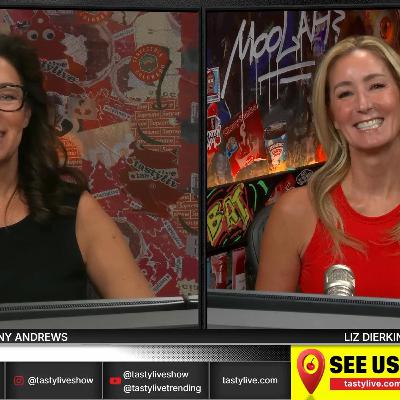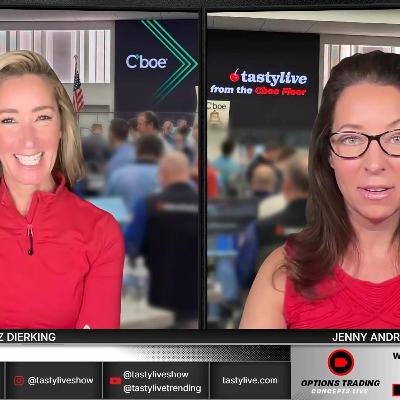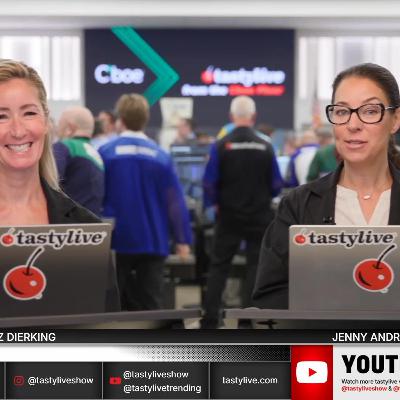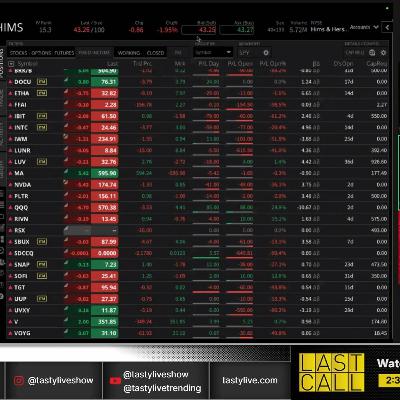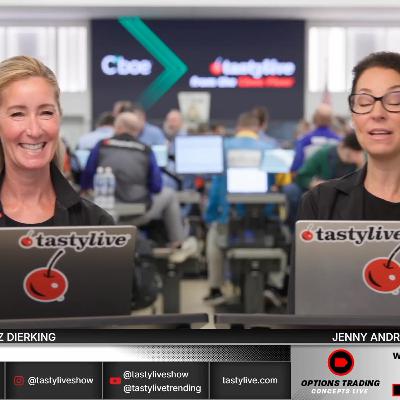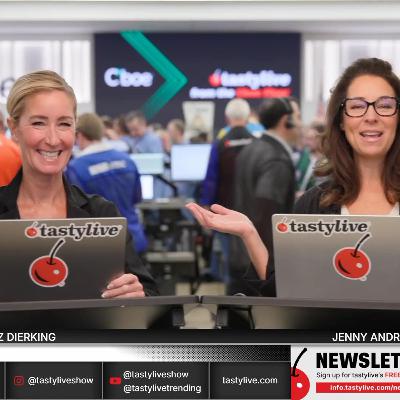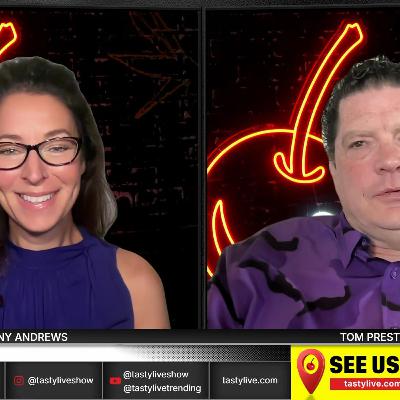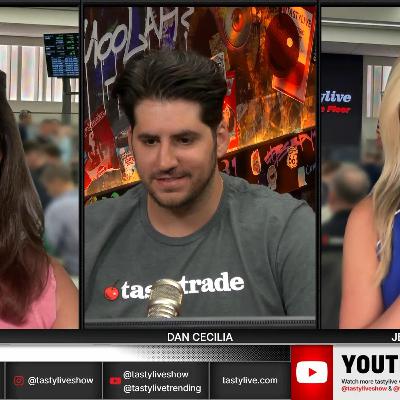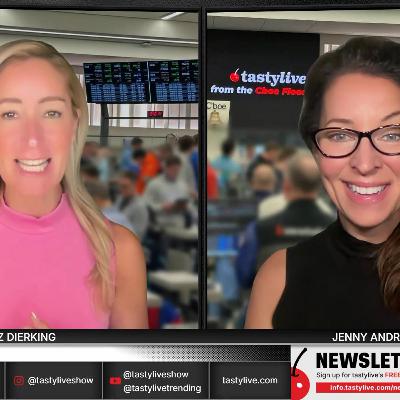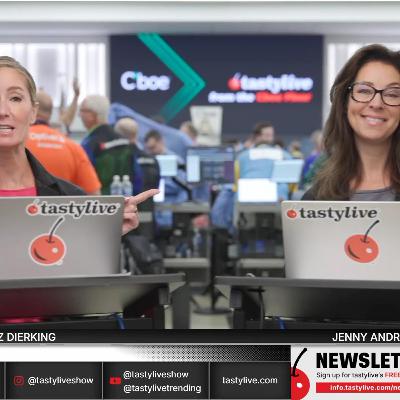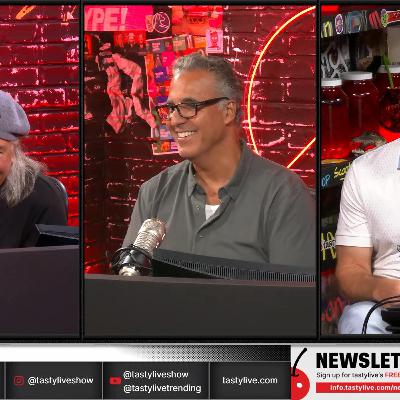Discover tastylive: LIZ & JNY
tastylive: LIZ & JNY

tastylive: LIZ & JNY
Author: tastylive
Subscribed: 7Played: 339Subscribe
Share
© ℗ & © copyright 2013 - 2025 tastylive. All Rights Reserved.
Description
Ex-market makers and suburban moms, Liz and Jenny, break down strategies and get to the basics of option trading. But this isn't preschool, this is where traders become better traders.
2267 Episodes
Reverse
Jenny Andrews and Liz Dierking discussed various market positions and trading strategies on their Thursday show. The S&P 500 futures were up 20 points while VIX dropped to the 15 handle, down from briefly touching 19.38 earlier in the week.
The hosts analyzed American Eagle Outfitters (AEO), which surged after announcing a Travis Kelce clothing line collaboration. They also examined post-earnings trade opportunities in Figure Technologies (FIG), which dropped 18%, discussing put spreads and risk management strategies.
In Wednesday's market action, S&P 500 futures recovered, trading up 37 points and recouping losses from the previous session. The hosts noted this "cancel crash" pattern, where the market effectively "took back everything it gave away yesterday."
Broadcasting live from the Cboe, Liz Dierking and Jenny Andrews discussed the market's resilience amid ongoing volatility, with charts showing the significant intraday recovery in equities.
Market selloff defense strategies revealed! Watch as we break down the "Delta Buster" SPY options trade that capitalizes on volatility skew without capital outlay. Learn about strategic buffer trades for CoreWeave ($CRWV), our DocuSign earnings position, and why timing matters with protective strategies. As the VIX hits 18.66, remember: "you can't buy insurance when the house is on fire." #OptionsTrading #MarketVolatility
In this segment, TP joins Liz Dierking and Jenny Andrews to analyze whether self-directed investors can outperform Wall Street products. Research comparing 2013-2025 performance shows that selling at-the-money SPY put spreads every 45 days outperformed simply buying S&P 500 index funds by about $1,300 on a $2,000 investment.
"If you are simply relying on Wall Street to take care of you, you are missing out," TP explains, emphasizing that Wall Street management fees may seem small but generate significant revenue for firms managing billions in assets.
The hosts demonstrate how retail traders can execute this simple strategy with defined risk in their tastytrade platform. They note that while index funds made money during the bull market, option strategies with "a little bit of knowledge and confidence" potentially deliver better returns.
Glenn Freiburger joins Liz and Jenny to explain how to measure volatility in forex markets. Unlike options trading, forex relies more on realized volatility metrics, which provide smoother data due to 24-5 trading with minimal gaps.
Glenn demonstrates two key volatility indicators in the TastyFX platform: Average True Range (ATR) and Bollinger Bands. ATR helps traders set realistic profit targets and stop losses by measuring expected price movement in pips, while Bollinger Bands visually represent volatility directly on price charts.
The trio executes a long position in the New Zealand dollar (NZD/USD) at the 0.58 handle, setting a 30-pip take-profit target to align with the currency pair's average daily movement. They also discuss previously established trades in natural gas and CoreWeave, taking profits on positions showing significant gains.
In this episode, Liz and Jenny dive into trading strategies ahead of NVIDIA's earnings release, dissecting expected moves and option strategies like ratio spreads and collars. They also explore 0 DTE SPX iron condors with different deltas and share insights on other trades, including Palantir (PLTR) and natural gas. Tune in for practical tips and a lively discussion on navigating the current market landscape!
Dan, the crypto expert from tastylive, joined Liz and Jenny to discuss recent crypto market movements and investment strategies. Bitcoin fell from $120K to around $111K over the weekend after a large seller dumped approximately 24,000 Bitcoin into the market following Jerome Powell's Jackson Hole speech.
Dan Dan the Crypto Man returns to discuss recent crypto market dynamics, noting a pullback following July's strong performance. He attributes this to typical August slowdown rather than fundamental changes, suggesting it presents buying opportunities for undervalued tokens.
In this episode of the Liz and Jenny Show, the hosts discuss various trading strategies, including the "ratchet" method for managing Zebra trades, particularly focusing on Intel (INTC). They explain how to adjust positions to reduce risk while maintaining profit potential. The conversation highlights the importance of individualized trading styles among viewers and incorporates live tweets from event attendees. The hosts emphasize the benefits of combining synthetic stock strategies with options, particularly in the context of a volatile market.
In a lively Tuesday session from the CBOE floor, Liz Dierking and Jenny Andrews analyzed market reactions following CPI data. The S&P 500 (SPX) climbed 46 points while VIX dropped below 15, reflecting decreased market volatility despite August typically being an active trading month.
The hosts demonstrated several capital-efficient options strategies to free up buying power in their account. They transformed a DocuSign (DOCU) naked put into a synthetic covered call using a zero extrinsic back ratio (ZEBRA) strategy, cutting required capital by nearly half while maintaining similar profit potential.
Similar adjustments were made to positions in HIMS and Intel (INTC), replacing deep in-the-money puts with alternative structures. For Archer Aviation (ACHR), they demonstrated how a combo strategy (buying a call and selling a put) creates a stock-equivalent position with significantly less capital than outright stock ownership.
The segment highlighted how understanding synthetic relationships between options positions can dramatically improve capital efficiency while maintaining similar risk profiles.
Dan, head of growth for tastycrypto and an eight-year veteran of the space, joined the show to discuss the surging market.
Bitcoin touched $122,000 overnight due to liquidations in the perpetual futures markets, while Ethereum broke above $4,200. Dan explained the typical crypto market cycle where Bitcoin gains lead to rotation into Ethereum and eventually to smaller altcoins.
Digital Asset Treasuries (DATs) are providing strong market support, with companies like Bitminer Technologies and SBAT functioning as "MSTRs for ETH." Dan highlighted how ETH ETF volumes have surged since July, with ETHA becoming a popular trading vehicle.
For traders looking to capitalize on crypto momentum, Dan suggested holding spot assets while selling premium against them to benefit from high implied volatility (around 80%). He predicted Ethereum could reach $8,000 in the near future and noted growing interest in Solana through treasury companies like UPXI.
This detailed market measure analysis revealed surprisingly weak correlations between major asset classes including S&P 500, U.S. dollar, and bonds. Research spanning 10 years of data showed essentially non-correlated relationships between these markets, contradicting traditional assumptions about their interconnectedness.
The only reliable correlation identified was between S&P 500 and volatility—when stocks rise, volatility falls and vice versa. This challenges many macro trading strategies that attempt to predict one market's movement based on another.
Comments
 United States
United States

